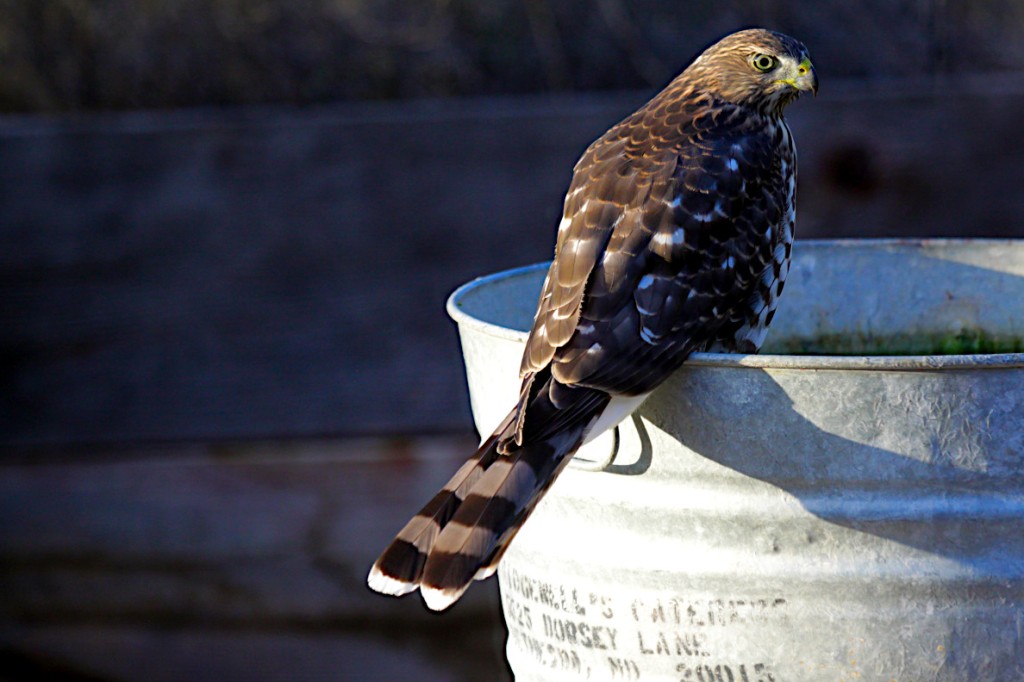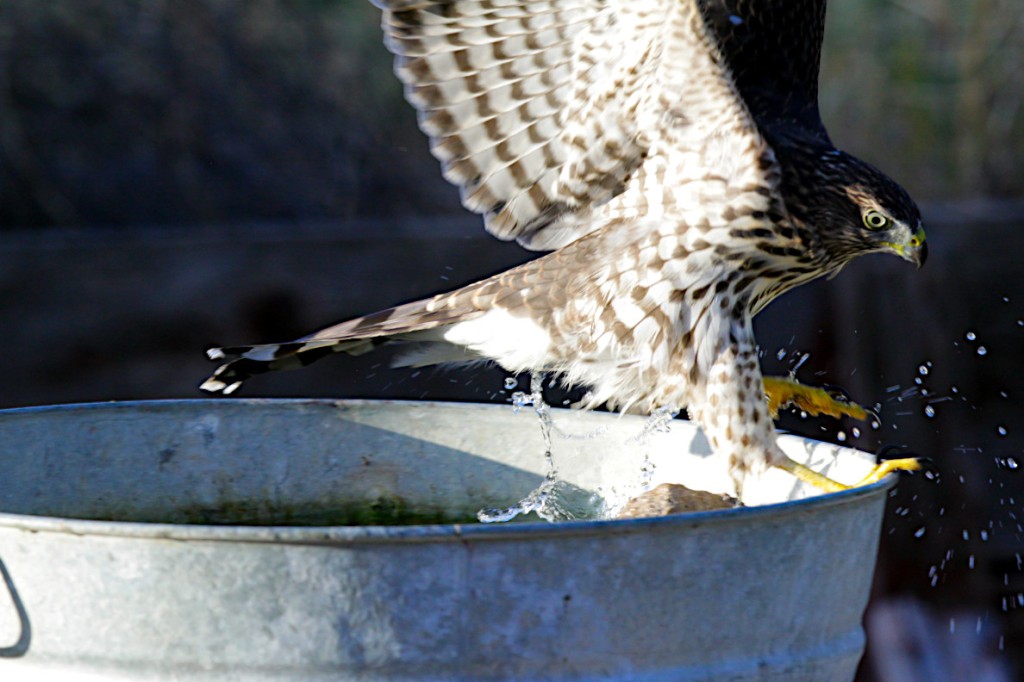It turned out the transmission was still leaking because of a bad shifter shaft seal that they failed to catch the first time around. The shop replaced it and now it’s not leaking anymore.
Truck to the Shop
The Sierra started leaking fuel from under the engine, and I was in Los Alamos, so I decided it was time to take it to the shop (this time around, I had no desire to work on it myself, especially with all my tools still in boxes in a bedroom; besides that, it needed several things I really couldn’t do myself, like fixing the fuel gauge and fixing a power steering leak). At the recommendation of a trusted mechanic friend who, unfortunately, doesn’t work on diesels himself, I took it to Expert Automotive on DP Road.
So I had the shop fix the fuel leak (which turned out to be a leaking injector return line between one bank of injectors); fix the power steering leak (which involved replacing the steering gear as well as the hoses); fix the fuel gauge (needed a new sending unit, which requires the bed be lifted off the truck to access); and while they were in there they told me the transmission pan was leaking and I said to take care of that, too, which included a new pan gasket and internal filter (the Allison 1000 has two filters, a “lifetime” internal one as well as an external spin-on that you change with every fluid change).
Needless to say all this wasn’t cheap, about $2400, but my goal is to get this thing reliable so that we can use it for towing a camper and for things like getting firewood, etc.
I haven’t yet had a chance to get the Subaru back home, so it’s still in Los Alamos too — so this morning I drove the truck from home to Los Alamos and then while I was walking the dog I discovered that the transmission is *still* leaking. It appeared to be from the back of the pan somewhere, but the truck was also parked nose-up on a slope, too, so who knows.
I took it back to the shop this morning. Hopefully they’ll get it right this time. I’m betting it’s one of two things: either the pan itself isn’t completely flat, or one of the sensors that plugs into the side of the transmission is leaking. Either way I bet I’m on the hook for a couple hundred bucks’ more parts.
All that said, I’m really liking the truck. I was prepared to spend some money getting it reliable; after all it’s twenty years old and has 233,000 miles on it.
2004 GMC Sierra 2500HD notes
I bought a 2004 GMC Sierra 2500HD in Los Alamos, NM in February, 2024. This is the “LLY” 6.6L Duramax diesel engine, which was introduced halfway through the 2004 model year. While the LLY has several documented issues, what made me interested is that the previous owner seemed to have addressed all of them.
The truck has a fair number of mods (EGR delete, S&B cold air intake, LBZ turbo intake, injectors by Industrial Diesel, an Allison 1000 built by Randy’s Transmission (“stage 2″), an Airdog 2 fuel pump/filter system, a 4″ turbo-back exhaust with a 5” tip, and a PPE Hot Plus “stage 2” tune.
Well, the truck smokes black on acceleration more than I would like, at least in the mountains, and I’d like to be able to tweak the tune that is on it.
The challenge is that the tuner remote went missing when the truck was stolen in Denver a couple of years back, so modifying the tune settings is easier said than done.
I contacted the folks at PPE about it. They don’t sell the Hot brand tuners anymore — all they sell for this truck now is an Xcelerator tuner — but I figured it might be worth buying a new one if I could simply overwrite the old tune with a new tuner.
Well, they told me that’s either not possible, or at the very least inadvisable. Overwriting an existing non-stock tune with a different tuner can corrupt your ECM.
So if I want to do anything other than run the existing tune, I need to take the truck to a GM dealer and have them re-flash the stock tune (which will probably cost an hour’s labor) and then flash the ECM again with a different tuner.
I may just leave it as-is, at least for the time being, as the truck is running just fine.
Fall color near the Enchanted Circle
Juvenile sharp-shinned hawk
F-250 Transfer Case WAY overfull
After our trip to Fourth of July a couple of weekends ago, which involved a lot of intense 4wd driving followed by some high-speed dirt and pavement driving (during which time I was still in 4×4 — turns out with these auto hubs you have to reverse to disengage them, otherwise they will stay locked), I noticed after I stopped in Tajique that there was transmission fluid all over the bottom of the truck. So much, in fact, that it was dripping all over the ground. It appeared to be coming from the front seal of the transfer case and not from the transmission.
I drove all the way back to Bernardo with the hubs still engaged, because I didn’t realize that I needed to reverse to disengage them. An easy way to tell that they’re still engaged is they make a hell of a lot of noise on pavement. Lesson learned.
Anyway, after a couple of weeks I finally got around to checking the transfer case fluid level. I was a little worried that with the fluid loss, I might have run it too low and caused some wear. Well … not so. I pulled the fill plug off and fluid literally fountained out of the hole. The transfer case was a couple of quarts overfull.
So, I suppose that explains why fluid was working its way past the front seal, especially at high speeds. What I don’t understand is how you even would overfill the transfer case. You’d have to fill it some way other than the fill plug to even do it.
I doubt it caused any damage or problems other than a messy undercarriage, but I’ll research it. I also kind of wonder whether the transfer case being overfull can affect your fuel economy.
…later edit. So it appears that this is a not-uncommon symptom on an older truck with an automatic transmission. The transmission’s rear seal leaks ATF and it goes straight into the transfer case. Eventually it gets so overfull that it starts coming out places where it shouldn’t. That’s not exactly good news but since it’s not leaking while sitting and the transmission works fine, I’m not going to worry about it too much.
Cold snap: Mercedes won’t start
It’s our first real cold snap (with snow on the ground, even) — it only got down to 31 last night, though.
I decided to try to see whether the Mercedes would start, and it won’t. It cranks plenty fast, but doesn’t fire.
I don’t think it’s that the fuel has gelled for a couple of reasons: one, it’s got about a B50 mix in it right now, which should prevent gelling to a much lower temperature; and also, I was able to get the F-250 (which has B100 in it) to start without too much trouble.
I think the issue is the Mercedes’ low compression numbers. It just doesn’t build up enough compression heat to ignite the fuel when it’s this cold outside.
It would be worthwhile to plug in the block heater and see if that makes a difference.
83 300SD (silver) troubleshooting
Mixed success with the car today.
I rebuilt the instrument cluster successfully, using plastic gears from Garagistic. Now both the main odometer and trip odometer are working again. Wasn’t a terribly difficult job.
I bought a replacement cruise control amplifier box on eBay, which the seller said had been tested good, but it didn’t make the cruise control work again. More troubleshooting needed.
And the driver’s seat is all screwed up; it’s leaned so far back that I can’t drive the car safely. I think I found a way to manually adjust it but it involves removing both cushions, and I haven’t tried it yet.
I also need to figure out why the car won’t kick down into first gear. I *think* it was working, and then stopped working. But if I’m on a slope, the car won’t even move because it starts off in 2nd gear. It does kick down in other gears (4->3 and 3->2), so I know the switch is working. I may need to adjust the ALDA and/or the Bowden cable.
Mercedes troubleshooting
Kent Bergsma has a whole series of YouTube videos on a car named Digby that he brought back to life, including detailed troubleshooting steps for an old, sick diesel Mercedes.
I decided to follow this process. The first steps are to get the engine running and then crack each fuel injector line individually to see whether the tone of the engine changes. If you get one for which the tone does *not* change, that strongly points to an issue with that injector.
Well, I did all five, and each one made the engine tone change noticeably. This makes me think there isn’t anything horribly wrong with any of the injectors.
It’s kind of bad news because it means I need to dig further into the engine to figure out why it’s idling rough.
Since I needed to replace the fuel filters anyway, and I had bought a couple of cans of Diesel Purge, I decided to go ahead and do that treatment this afternoon. I had already used about half a can of DP to fill up the F-250’s fuel filter when I replaced it, so I poured the remaining 1.5 cans into a 2-liter soda bottle and connected the fuel supply and return lines to the bottle. I left the old fuel filters in place, figuring I would replace them after doing the treatment.
Well, I can’t say I noticed anything very dramatic. I did run the engine at all kinds of different RPMs, high and low. The DP in the bottle did not turn a filthy dark color like some people say it does if your fuel system is really dirty. And while I think it may have smoothed the engine out a little, it’s really not very noticeable.
So I used up the Diesel Purge, then replaced both fuel filters.
Next steps for troubleshooting how the engine is running are a compression test on each cylinder and a valve adjustment. I also want to pop test the injectors on the bench.

















You must be logged in to post a comment.